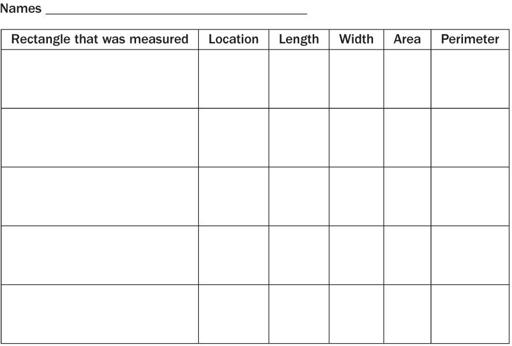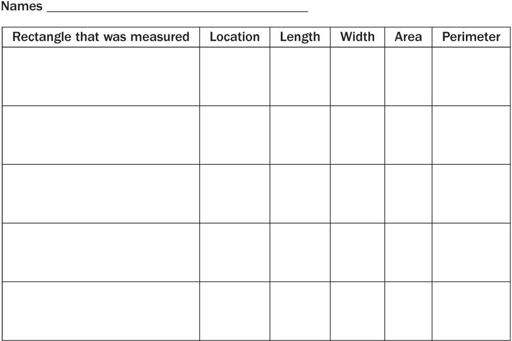Teaching the Common Core Math Standards With Hands-On Activities, Grades 3-5 (43 page)
Read Teaching the Common Core Math Standards With Hands-On Activities, Grades 3-5 Online
Authors: Judith A. Muschla,Gary Robert Muschla,Erin Muschla-Berry
Tags: #Education, #Teaching Methods & Materials, #Mathematics, #General

BOOK: Teaching the Common Core Math Standards With Hands-On Activities, Grades 3-5
10.52Mb size Format: txt, pdf, ePub
Activity: Measuring Rectangles
This is a two-day activity
. Students will work in pairs or groups of three. On the first day, they will measure the lengths and widths of various rectangles in the classroom, find areas and perimeters, and record the measurements in a table. The teacher will use data of selected rectangles, and write questions that require students to find the length of an unknown side. On the second day, students will solve the problems.
Materials
Rulers (with 1-inch or-inch scales); yardsticks; reproducible, “Group Data Table,” for each pair or group of students.
Preparations
Make enough copies of the reproducible so that you may cut out a “Group Data Table” for each group.
Procedure
Day One
1.
Review the formulas for finding the perimeter of a rectangle and the formula for finding the area of a rectangle, as provided in the Background.
2.
Explain that each pair or group of students will select three rectangles in the classroom to measure, for example: book covers, floor tiles, desks, bulletin boards, doors, windows, shelves, and computer screens.
3.
Distribute a copy of the “Group Data Table” to each pair or group of students. Explain that students are to complete the table for each rectangle they measure.
4.
Explain that they are to measure the length and width of their rectangles, one at a time. Suggest that they measure to the nearest inch or half inch, depending on the abilities of your students. If necessary, demonstrate how they can do this. They are to use their measurements of a rectangle to find its perimeter and area. Remind them to use correct units, for instance, square units for area. Suggest that students use the appropriate formula for finding perimeters and areas.
5.
Instruct your students to hand in their completed tables at the end of class.
6.
Before the next class, use the information from students' tables to develop questions. Try to develop one or two questions based on one rectangle for each pair or group of students. One question could relate to area and the other could be about perimeter. Here are two examples: Group 1 [or you may prefer to name the students] said that this book's cover is 9 inches long and has an area of 54 square inches. What is the cover's width? Given that the perimeter of a rectangle is 40 inches, and the length of a side is 12 inches, what is the length of the opposite side?
Day Two
1.
Ask students the questions you developed. (
Note:
Students who measured a particular rectangle should refrain from answering questions about it.)
2.
Whenever possible, hold up or stand next to a rectangle to help students visualize the dimensions.
Closure
Ask students to write exit cards that explain how to find a missing side if they are given the area and length of one side of a rectangle. Ask students to explain how to find a missing side of a rectangle if they are given the perimeter and the length of a side.
You might also ask your students questions, such as the following:
- Which formula for finding the perimeter of a rectangle,
 or
or , do you find easier to work with? Why?
, do you find easier to work with? Why? - What is meant by the term “square unit”?
Group Data Table
Measurement and Data: 4.MD.4
“Represent and interpret data.”
4. “Make a line plot to display a data set of measurements in fractions of a unit. Solve problems involving addition and subtraction of fractions by using information presented in line plots.”
Background
A line plot, also known as a dot plot, displays data along a number line. Each value of the data is marked with a symbol noting the frequency.
For example, a line plot displaying the lengths is shown below.
is shown below.

Note that an X is placed above the value each time the value appears.
Activity: Pencils and Line Plots
Students will measure their pencils and draw a line plot that shows this data.
Materials
Ruler with a-inch scale; a pencil; reproducible, “Pencil Lengths,” for each student. (
Note:
Pencils should be of various lengths.)
Other books
Dolled Up for Murder by Deb Baker
The Women's Health Big Book of 15-Minute Workouts: A Leaner, Sexier, Healthier You--In 15 Minutes a Day! by Yeager, Selene, Editors of Women's Health
Return of a King: The Battle For Afghanistan by Dalrymple, William
Riding Dirty on I-95 by Nikki Turner
Nameless Night by G.M. Ford
The Superhero's Origin (The Superhero's Son Book 5) by Lucas Flint
A Wanted Man by Linda Lael Miller
Lady Thief: A Scarlet Novel by Gaughen, A.C.
Blurred Lines (Watching Her) by Metal, Scarlett
In Bed with the Duke by Annie Burrows


